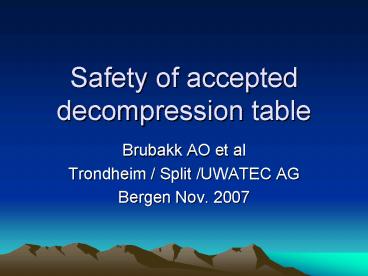Safety of accepted decompression table - PowerPoint PPT Presentation
1 / 27
Title:
Safety of accepted decompression table
Description:
... accepted decompression table. Brubakk AO et al. Trondheim / Split ... tolerance to decompression is in reality an index of the degree of gas embolism tolerated ... – PowerPoint PPT presentation
Number of Views:45
Avg rating:3.0/5.0
Title: Safety of accepted decompression table
1
Safety of accepted decompression table
- Brubakk AO et al
- Trondheim / Split /UWATEC AG
- Bergen Nov. 2007
2
(No Transcript)
3
(No Transcript)
4
Effect of Nitroglycerin on bubble formation in
manValade et al 2006.
Bubbles/cm2
5
Dry / In-water dives54msw/20min 24msw/70min
Bub/cm2 P(DCS)
6
Total decompression timeAir dives
Minutes
7
HSE 1997
- The outcome of a particular dive is determined by
many different physical and physiological factors
normally not accounted for in present
decompression tables. - All present tables seem to be unsatisfactory for
very high gas loads.
8
Health Safety Executive 1997
- The amount of separated gas in the pulmonary
artery can be used as an indicator of
decompression risk. - Present procedures probably produce an
unacceptable large amount of separated gas in the
pulmonary artery in a significant number of
divers.
9
(No Transcript)
10
The effect of prT on DCS incidence (HSE 1996)
11
Dive Computer Tests60 fsw Multi-Level Dive
1(24 min. _at_ 40 fsw)
Required Decompression Time
No-Decompression Time
Neuman T., Pers. Comm.
12
Behnke 1951/1969
- From the point of view of decompression
procedures the problem is straightforward - regulate decompression so as to prevent bubble
evolution - if bubbles form, control their number and size so
that symptoms do not supervene. - Bubbles form as soon as a state of
supersaturation is initiated and tolerance to
decompression is in reality an index of the
degree of gas embolism tolerated - There is a sharp demarcation limit of perhaps 5
feet in diving depth separating injury from a
state of well-beeing
13
Air dives SurDO2 SNSC 1992
DCS incidence 17
DCS incidence 0
14
Risk of DCS
- 60 feet / 80 minutes
- Decompression
- 8 min - pDCS 2.8
- 80 min - pDCS 2
- Wheathersby et al 1984
15
(No Transcript)
16
(No Transcript)
17
(No Transcript)
18
(No Transcript)
19
318 msw. 9 different gas mixes, 11 hours
decompression
20
Copernicus
21
Copernicus
- Copernicus consists of
- The model itself. A descriptive model of the
mechanisms behind the occurence of serious (CNS)
DCS (evolution of vascular bubbles) - A control algorithm. It calculates a procedure
that control the model according to our request
(Dynamic optimization algorithm) - Validation strategy through bubble measurement
rather than DCS/NO-DCS endpoint - The model will have two distinct applications
- Use the model as a simulator to compare and
evaluate procedures and logged dives - Use accepted risk/bubble scores as threshold for
calculating optimal decompression schedules
22
Physiological model
- Individually adaptive
- Input
- Weight
- Height
- Fitness (fat percentage)
- Gender
- Cardio-pulmonary performance
- Workload
23
Total decompression timeAir dives
Minutes
24
Air-dive 24msw/70min
Min
Total deco 72 min
Total deco 69 min.
25
Buhlman / Copernicus24msw/70 min
26
Possible, tentative and surprising conclusion
- Dives with long, lt 30 minutes, bottom time may
benefit from deep stops - Dives with short. gt 30 minutes, bottom time will
not benefit from deep stops.
27
- People who think they know it all really annoys
those of us who really do.































